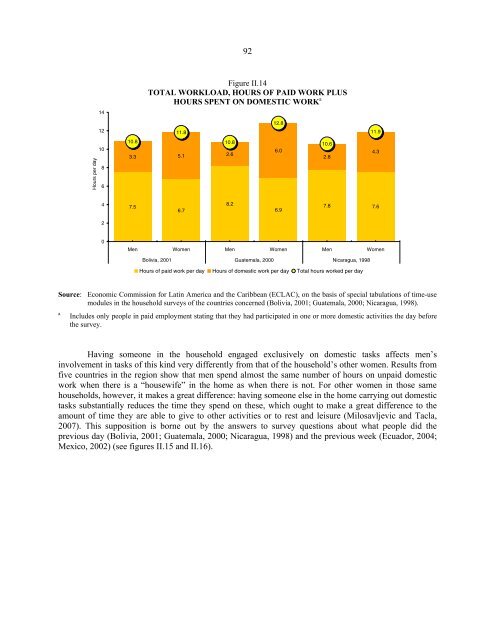Women in Latin America and the Caribbean - Cepal
Women in Latin America and the Caribbean - Cepal
Women in Latin America and the Caribbean - Cepal
You also want an ePaper? Increase the reach of your titles
YUMPU automatically turns print PDFs into web optimized ePapers that Google loves.
92<br />
14<br />
Figure II.14<br />
TOTAL WORKLOAD, HOURS OF PAID WORK PLUS<br />
HOURS SPENT ON DOMESTIC WORK a<br />
12<br />
11.8<br />
12.8<br />
11.9<br />
Hours per day<br />
10<br />
8<br />
6<br />
10.8<br />
10.8<br />
3.3 5.1 2.6<br />
6.0<br />
10.6<br />
2.8<br />
4.3<br />
4<br />
7.5<br />
6.7<br />
8.2<br />
6.9<br />
7.8 7.6<br />
2<br />
0<br />
Men <strong>Women</strong> Men <strong>Women</strong> Men <strong>Women</strong><br />
Bolivia, 2001 Guatemala, 2000 Nicaragua, 1998<br />
Hours of paid work per day Hours of domestic work per day Total hours worked per day<br />
Source: Economic Commission for Lat<strong>in</strong> <strong>America</strong> <strong>and</strong> <strong>the</strong> <strong>Caribbean</strong> (ECLAC), on <strong>the</strong> basis of special tabulations of time-use<br />
modules <strong>in</strong> <strong>the</strong> household surveys of <strong>the</strong> countries concerned (Bolivia, 2001; Guatemala, 2000; Nicaragua, 1998).<br />
a<br />
Includes only people <strong>in</strong> paid employment stat<strong>in</strong>g that <strong>the</strong>y had participated <strong>in</strong> one or more domestic activities <strong>the</strong> day before<br />
<strong>the</strong> survey.<br />
Hav<strong>in</strong>g someone <strong>in</strong> <strong>the</strong> household engaged exclusively on domestic tasks affects men’s<br />
<strong>in</strong>volvement <strong>in</strong> tasks of this k<strong>in</strong>d very differently from that of <strong>the</strong> household’s o<strong>the</strong>r women. Results from<br />
five countries <strong>in</strong> <strong>the</strong> region show that men spend almost <strong>the</strong> same number of hours on unpaid domestic<br />
work when <strong>the</strong>re is a “housewife” <strong>in</strong> <strong>the</strong> home as when <strong>the</strong>re is not. For o<strong>the</strong>r women <strong>in</strong> those same<br />
households, however, it makes a great difference: hav<strong>in</strong>g someone else <strong>in</strong> <strong>the</strong> home carry<strong>in</strong>g out domestic<br />
tasks substantially reduces <strong>the</strong> time <strong>the</strong>y spend on <strong>the</strong>se, which ought to make a great difference to <strong>the</strong><br />
amount of time <strong>the</strong>y are able to give to o<strong>the</strong>r activities or to rest <strong>and</strong> leisure (Milosavljevic <strong>and</strong> Tacla,<br />
2007). This supposition is borne out by <strong>the</strong> answers to survey questions about what people did <strong>the</strong><br />
previous day (Bolivia, 2001; Guatemala, 2000; Nicaragua, 1998) <strong>and</strong> <strong>the</strong> previous week (Ecuador, 2004;<br />
Mexico, 2002) (see figures II.15 <strong>and</strong> II.16).











